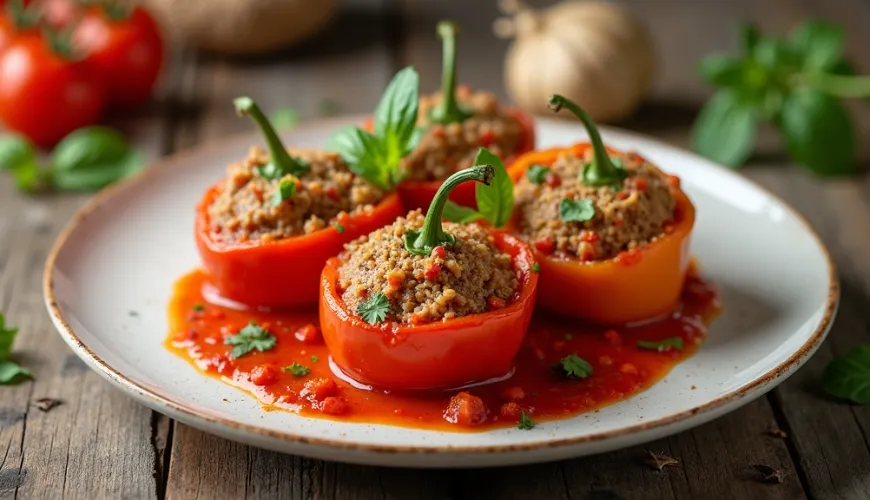
Discover the magic of stuffed peppers with minced meat baked in the oven

Stuffed Peppers Baked in the Oven - A Tradition That Never Tires
There are dishes that are passed down from generation to generation in Czech households. One of them is undoubtedly stuffed peppers with minced meat baked in the oven. This scent of childhood, Sunday lunches with family, and honest home cooking holds a special place in our hearts. And this classic is experiencing a quiet comeback in recent years, not only in kitchens but also in the modern concept of healthy and sustainable eating. How is this possible?
At first glance, it might seem that stuffed peppers, especially those baked in the oven with tomato sauce, belong to the heavier, hearty meals of our grandmothers. In reality, however, it is a very versatile dish that can easily be adapted to current nutritional trends – whether it’s lighter eating, ecological cooking, or using seasonal and local ingredients.
A Classic That Never Tires
The basic recipe is known to almost everyone: peppers stuffed with minced meat and rice, baked in the oven, sometimes complemented with tomato sauce. This dish combines everything Czech cuisine loves – richness, flavor, and a certain dose of nostalgia. The balanced combination of meat, grains, and vegetables also corresponds to the principles of good nutrition, provided quality meat and suitable preparation without unnecessary added fat are used.
Baking in the oven is the key element that sets this dish apart from other preparation methods. Unlike frying or boiling in a pot, the oven allows for slow baking, where the flavors of the individual components meld, and the pepper softens beautifully without losing its shape or freshness. The result is a dish that is not only tasty but also aesthetically appealing.
Why Baked in the Oven and Not Otherwise?
Traditionally, stuffed peppers are often prepared by boiling in a pot with sauce. However, baking in the oven brings several advantages. Firstly, it allows the consistency of the peppers to be preserved, which often overcook when boiled. Furthermore, baking is gentler on flavor – the sauce does not evaporate but thickens and absorbs the taste of the meat and vegetables.
Another benefit is that baking in the oven allows for the use of less fat, as there is no need to pre-fry the meat. Additionally, the baking dish can be covered, creating almost a steam bath that ensures juiciness. By adding tomato sauce or vegetable broth, a mild, slightly sweet flavor is achieved, which complements the natural sweetness of ripe peppers.
Plant-Based and Local Alternatives
Nowadays, as more people think about what they eat and where their food comes from, traditional recipes are taking on new forms. Minced meat can be partially or completely replaced by a plant-based substitute, such as red lentils, tempeh, tofu, mushrooms, or a mixture of nuts and legumes. Combined with rice and spices, a tasty and nutritious filling is created, which does not fall short of the meat version.
An example is the story of a family from Brno, who decided to eat more plant-based but did not want to give up their favorite dishes. One Friday evening, they replaced the minced beef in stuffed peppers with a mixture of lentils, rice, and chopped mushrooms. The result surprised not only the children but also the grandfather, who praised that "it’s like grandma’s, just a bit different."
Seasonality and locality of ingredients are another step towards sustainable dining. Peppers from Czech gardens are the sweetest and juiciest in the autumn months. Moreover, if you use rice from organic farming or replace it with buckwheat, millet, or spelt wheat, you add another dimension to the dish with minimal ecological footprint.
Spices That Work Wonders
Although the basic recipe is simple, the true depth of flavor is provided by the combination of spices and herbs. Traditionally, marjoram, garlic, pepper, cumin, or allspice are used. More pronounced versions may include smoked paprika, cinnamon, or a pinch of nutmeg. The tomato sauce, often served with these peppers, can be enriched with fresh basil or thyme – creating a bridge between classic Czech and Mediterranean cuisine.
Tomato sauce isn’t a necessity, but its gentle acidity and sweetness beautifully balance the richer taste of the meat and rice. If you prepare it from fresh tomatoes, onions, carrots, and a bit of honey, you’ll get a sauce that is not only tasty but also full of vitamins and without unnecessary added sugar.
How to Make the Ideal Stuffed Pepper?
The basic version of the recipe consists of these ingredients:
- 6 larger green or red peppers
- 500 g minced meat (preferably a mix of beef and pork or poultry)
- 1 cup cooked rice
- 1 egg
- 1 small onion, finely chopped
- salt, pepper, marjoram, garlic to taste
- tomato sauce (from tomato paste, broth, onion, spices)
The peppers are deseeded, filled with the meat and rice mixture, placed in a baking dish, covered with sauce, and baked for about 45 minutes at 180°C. However, the variations can be endless – from using bulgur to adding cheese to the filling to baking in a remoska, which brings back the magic of old times.
Stuffed Peppers in the Modern Diet
Interestingly, stuffed peppers are also finding their way into restaurants focused on healthy eating and vegetarian cuisine. The reason is simple – it’s a filling yet easily digestible dish that can be prepared from a minimal amount of ingredients and without waste. If you prepare food at home for a lunchbox, stuffed peppers are also ideal for transport and reheating – they last up to three days in the fridge and taste great even cold.
A quote from chef Martin Hrabal from a Prague vegetarian restaurant sums it up perfectly: “A stuffed pepper is like a blank canvas – it all depends on what you fill it with."
In conclusion, it's good to remember that even such a traditional dish as stuffed peppers baked in the oven can be modern, light, and sustainable. All it takes is to rely on quality ingredients, honest preparation, and openness to new flavor combinations. Whether you serve them with tomato sauce or just with a piece of fresh bread, one thing is certain – it’s a dish that connects generations and never loses its charm.

